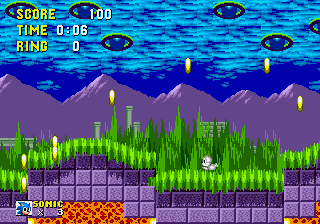Chiki Chiki Machine Mou Race (Japan)
Chiki Chiki Machine Mou Race (Japan) をブラウザでオンラインプレイ。ダウンロード不要。
Chiki Chiki Machine Mou Race (Japan) について:
.png)
Chiki Chiki Machine Mou Race: The Quirky Japanese Racing Phenomenon
Chiki Chiki Machine Mou Race delivers an exhilarating and distinctively Japanese take on racing games, combining colorful visuals with innovative gameplay mechanics that set it apart from conventional racing titles of its era. Released exclusively in Japan for the Famicom in 1987 by Nichibutsu, Chiki Chiki Machine Mou Race follows a format similar to slot car racing, where players control miniature vehicles around twisting, obstacle-filled tracks. What makes Chiki Chiki Machine Mou Race particularly unique is its perspective—using an overhead view that displays large portions of the track at once, allowing players to strategize about upcoming turns and hazards. The game's name itself—roughly translating to 'Speedy Machine More Race'—captures the frantic energy of its gameplay, as players must maintain control of their vehicles while navigating tight corners, avoiding obstacles, and competing against aggressive AI opponents. Throughout Chiki Chiki Machine Mou Race, players can upgrade their vehicles between races, enhancing speed, handling, and durability to tackle increasingly challenging circuits. The tracks in Chiki Chiki Machine Mou Race feature various themes and hazards, from basic oval circuits to complex layouts with oil slicks, water hazards, and dangerous shortcuts that reward risk-taking. With its charming miniature car aesthetic, challenging gameplay, and distinctive Japanese racing style, Chiki Chiki Machine Mou Race represents a fascinating chapter in racing game evolution that offered a different approach to the genre before 3D perspectives became standard.
The Miniature Marvel: How Chiki Chiki Machine Mou Race Carved Its Racing Lane
Chiki Chiki Machine Mou Race was developed and published by Nichibutsu (Nihon Bussan) in 1987 for the Japanese Famicom, during a period when racing games were still establishing their conventions and experimenting with different perspectives and gameplay approaches. The game drew inspiration from the popularity of miniature racing toys in Japan, including slot cars and radio-controlled vehicles, translating that physical hobby into video game form. Chiki Chiki Machine Mou Race represented an interesting alternative approach to racing games before the pseudo-3D perspective of titles like Out Run and Rad Racer became the standard for the genre. The overhead perspective allowed for greater track visibility and strategic planning, creating a racing experience focused more on navigation and obstacle avoidance than pure speed. The game never received an international release during the 8-bit era, remaining exclusive to Japan and relatively unknown to Western players until the growth of interest in Japanese retro games decades later. Chiki Chiki Machine Mou Race's legacy lives on primarily among collectors and enthusiasts of Japanese Famicom titles, appreciated for its unique approach to racing game design that differed significantly from its contemporaries. Today, the game represents an interesting case study in alternative racing game design, showcasing how developers created distinctive experiences within the limitations of 8-bit hardware by emphasizing different aspects of the racing experience than what would eventually become genre conventions.
Mastering the Miniature Speedways of Chiki Chiki Machine Mou Race
Speeding Through the Circuit: Chiki Chiki Machine Mou Race's Distinctive Elements
- Unique top-down perspective showing large portions of the track simultaneously
- Miniature car aesthetic reminiscent of slot car and RC racing
- Vehicle upgrade system for enhancing speed, handling, and durability
- Diverse track designs with multiple themes and environmental hazards
- Strategic racing requiring mastery of drifting and precise control
- Challenging AI opponents with aggressive racing styles
- Risk-reward shortcuts that can dramatically affect race outcomes in Chiki Chiki Machine Mou Race
From Rookie to Racing Champion
In Chiki Chiki Machine Mou Race, players control miniature vehicles from a top-down perspective, navigating through various tracks while competing against AI opponents. The core gameplay revolves around mastering the distinctive physics of the game—vehicles in Chiki Chiki Machine Mou Race have significant momentum and require anticipating turns well in advance, with drifting mechanics that demand practice to perfect. Vehicle control includes acceleration, braking, and steering, with the challenge coming from maintaining optimal speed while navigating tight corners and hazards. Throughout the championship mode, players earn points and currency based on race performance, which can be invested in vehicle upgrades between races. These improvements in Chiki Chiki Machine Mou Race are essential for remaining competitive as the difficulty increases in later circuits. Tracks feature various obstacles including oil slicks that reduce traction, water puddles that slow vehicles, and barriers that can damage cars upon collision. The game requires both quick reflexes and strategic thinking, as choosing when to take risks with shortcuts or aggressive maneuvers can determine race outcomes. This blend of accessible controls with deep racing mechanics creates an engaging experience that stands out among racing-themed retro games, requiring practice and skill to master the unique handling characteristics of Chiki Chiki Machine Mou Race's miniature speedsters.
.png)
.png)
.png)
.png)
 (Rev A).png)
 (Proto).png)
.png)
.png)
(sUppLeX).png)
.png)

 (En,Ja).png)